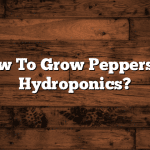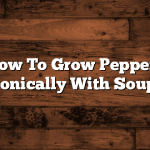Benefits of growing herbs and spices hydroponically
Hydroponic cultivation of herbs and spices offers numerous benefits that make it an attractive option for growers. One major advantage is the ability to control and optimize the growing environment. In hydroponics, plants are grown in a soilless medium and supplied with a nutrient-rich solution, which allows for precise control over the key environmental factors such as temperature, humidity, and pH levels. This level of control ensures that the plants receive the optimal conditions required for their growth, resulting in healthier and more vigorous herb and spice crops.
Another benefit of hydroponic herb and spice cultivation is the ability to maximize space utilization. Unlike traditional soil-based cultivation, hydroponics enables growers to vertically stack the plants, making use of the vertical space available. This vertical farming technique allows for a higher density of plants per unit area, ultimately increasing the overall crop yield. Furthermore, by eliminating the need for soil, hydroponics minimizes the risk of soil-borne diseases and pests, reducing the reliance on pesticides and making the cultivation process more sustainable.
Types of herbs and spices suitable for hydroponic cultivation
Hydroponic cultivation offers a unique opportunity to grow a wide variety of herbs and spices in a controlled environment. With the right techniques and conditions, many popular and sought-after herbs and spices thrive in hydroponic systems. One such herb that flourishes in hydroponic cultivation is basil. Known for its distinct flavor and aroma, basil is a versatile herb used in various culinary dishes. Other herbs like mint, cilantro, and parsley also thrive in hydroponics, offering fresh and potent flavors to elevate dishes to new heights.
In addition to herbs, hydroponic cultivation is well-suited for growing a range of spices. One example is chili peppers, which can be challenging to grow in traditional soil-based systems due to their specific requirements for warmth and moisture. Hydroponics provides the control necessary to create the perfect growing conditions for chili peppers, enabling farmers to produce a steady supply of robust and flavorful varieties. Similarly, spices like oregano, thyme, and rosemary adapt well to hydroponic cultivation, allowing for consistent and high-quality yields that meet the demands of discerning consumers.
Factors affecting the profitability of hydroponic herb and spice growth
Hydroponic herb and spice cultivation offers numerous advantages, including increased control over growing conditions, higher yields, and reduced use of water and land. However, profitability in this field is influenced by various factors that need to be carefully considered. One major factor is the initial investment required for setting up a hydroponic system, which includes purchasing the necessary equipment, such as grow lights, nutrient solutions, and growing mediums. The cost of these components can vary depending on the size and complexity of the system, and it can take time to recover this investment and start earning profits.
Another crucial factor affecting profitability is the market demand for hydroponically grown herbs and spices. While customers are increasingly becoming aware of the benefits of hydroponic produce, the demand for these specific crops may vary. Market research and understanding consumer preferences are essential to determine which herbs and spices have a higher demand and can fetch better prices. Additionally, factors such as seasonality, competition from conventionally grown produce, and the availability of existing supplier networks can all impact the profitability of hydroponic herb and spice growth. Therefore, it is important to assess the market dynamics and potential before deciding which crops to cultivate through hydroponics.
Techniques for successful hydroponic herb and spice cultivation
Hydroponic cultivation of herbs and spices offers numerous advantages, including controlled environments and optimized nutrient delivery systems that enhance growth and yield. Successful hydroponic herb and spice cultivation requires careful attention to a few key techniques.
Firstly, it is essential to choose the right growing medium. Coco coir, rockwool, and perlite are commonly used in hydroponic systems for their ability to retain moisture and provide adequate aeration to the roots. Secondly, maintaining proper pH levels is crucial. Most herbs and spices prefer slightly acidic conditions, with a pH range between 5.5 and 6.5. Regular monitoring and adjustment of pH levels are necessary to ensure optimal nutrient absorption. Additionally, providing adequate lighting plays a vital role in the growth of hydroponically cultivated herbs and spices. Most plants require at least six to eight hours of direct light each day, and the use of full-spectrum LED grow lights can mimic natural sunlight effectively.
In conclusion, implementing these techniques in hydroponic herb and spice cultivation can help maximize yield and ensure healthy plant growth. By selecting an appropriate growing medium, maintaining optimal pH levels, and providing sufficient lighting, growers can create favorable conditions for their hydroponic crops. These techniques, combined with proper nutrient solutions and regular monitoring of plant health, are fundamental in achieving success in hydroponic herb and spice cultivation.
Market demand and potential for hydroponically grown herbs and spices
Hydroponic cultivation of herbs and spices has gained immense popularity in recent years, primarily due to the increased market demand for fresh and flavorful produce. Consumers are becoming increasingly conscious of the quality, origin, and sustainability of the food they consume. This has created a growing market for hydroponically grown herbs and spices, as they are considered to be more environmentally friendly, free from pesticides, and have a longer shelf life compared to conventionally grown counterparts.
Additionally, the potential for profitability in hydroponic herb and spice growth is enticing for farmers and entrepreneurs. With hydroponic systems, herbs and spices can be cultivated year-round, irrespective of weather conditions. This allows for a constant supply of fresh produce, which is highly valued by restaurants, gourmet food stores, and health-conscious individuals. Moreover, hydroponic cultivation maximizes space utilization, enabling farmers to grow a greater quantity of herbs and spices in a smaller area. This, coupled with the potential for higher crop yields and enhanced control over plant growth and nutrition, offers a promising prospect for those venturing into hydroponic herb and spice cultivation.






